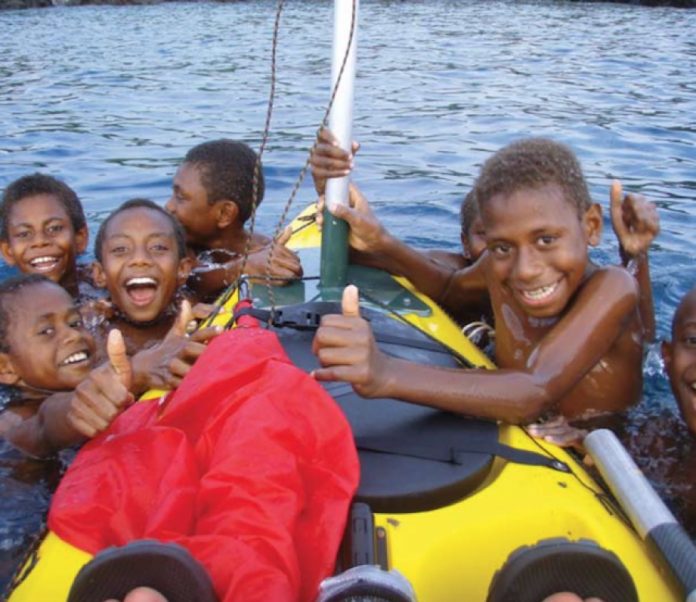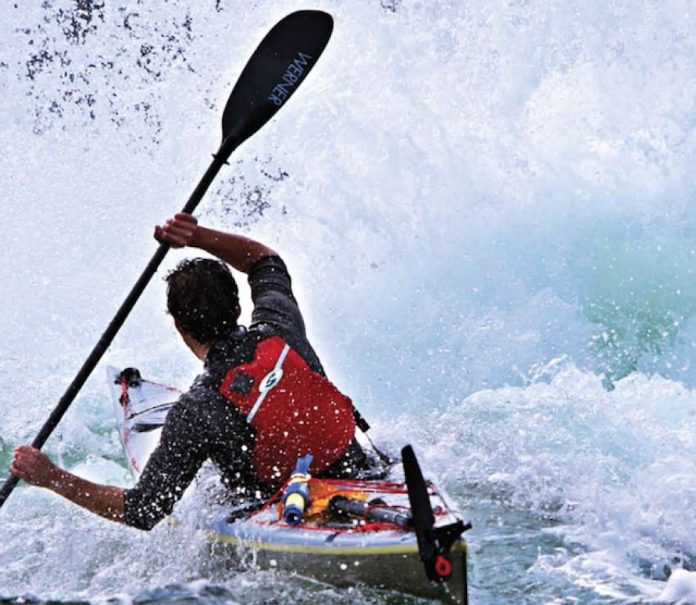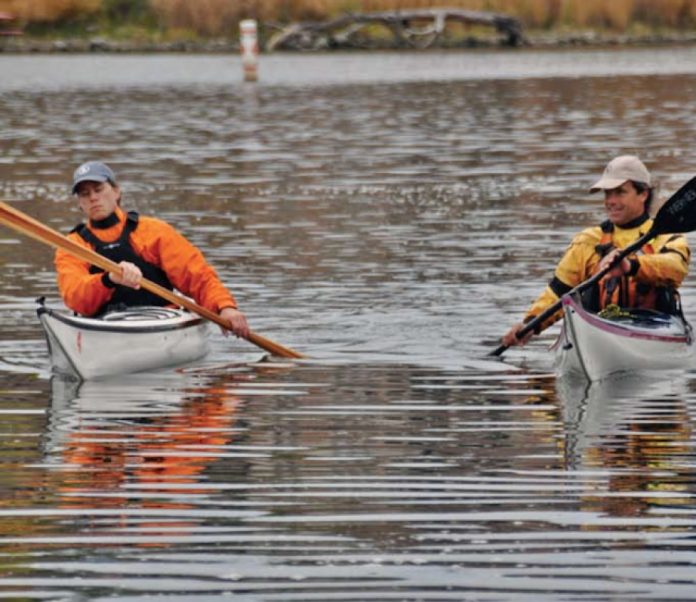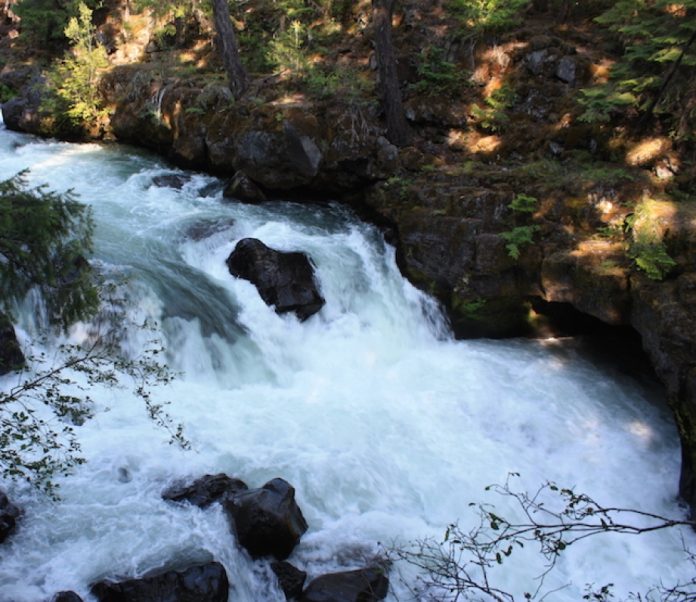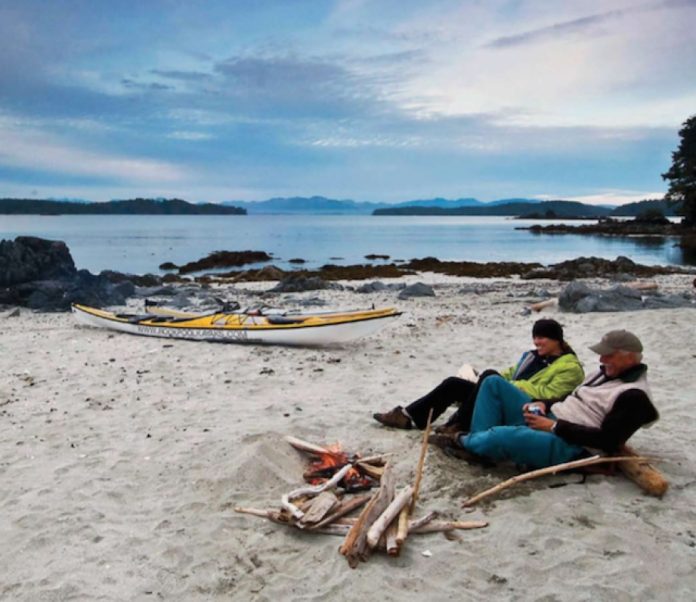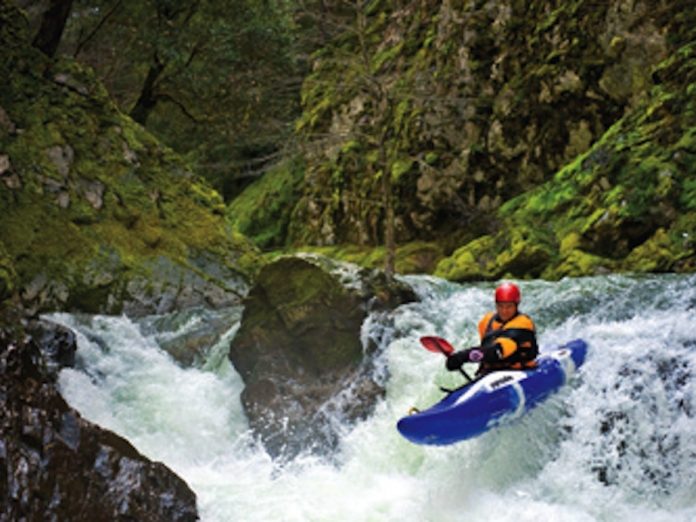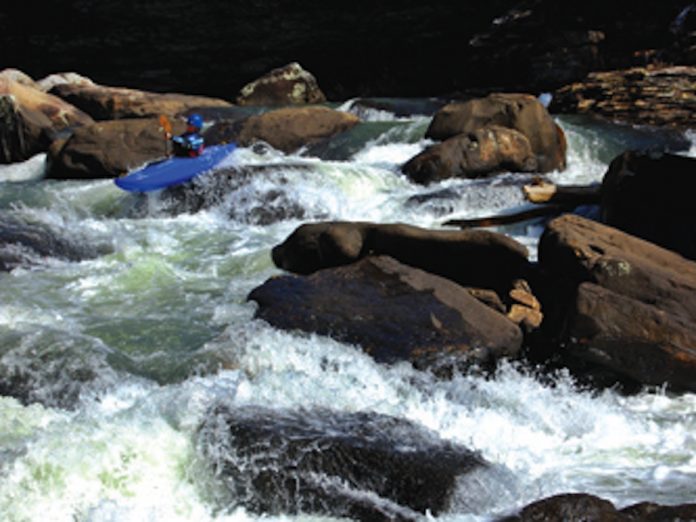I was paddling as hard as I could, but my bow kept falling off the wind. I looked nervously at the GPS, and then turned it off so I could concentrate on the sea. Fifteen minutes later I turned it back on, to confirm my fears that I was drifting inexorably downwind. I was alone in the vastness, where I wanted to be, except that I would have been so much happier if I were on course. A flying fish leapt out of the water and skimmed over the waves, bright and silvery in the morning sunlight. Gaua Island was still 40 miles away, and if I missed that tiny spot of terra firma, I would die. The next landfall was Australia, 1,500 miles to the west.
I turned the GPS off again and put it in my pocket, because the digital read- out couldn’t save me—it would only quantify my doom. When my boat slid off the next wave, my outrigger caught in the trough and the kayak rotated 30 degrees, as if I were dancing with one foot nailed to the floor.
Life had felt so jaunty the day before when I lashed the outrigger to my plastic Ocean Kayak sit-on-top, fashioning a few pieces of wood with a machete and tying them together with some string. The outrigger was supposed to give me stability so I could sleep, because I had romantically envisioned a placid ocean and a peaceful night alone beneath the Southern cross.
Now, bobbing on unfettered ocean swells in the northern Vanuatu chain, I looked behind me to see Maewo Island, only eight miles away but unreachable because it was upwind. Ahead of me, Gaua Island lay below the horizon, recognizable only as a waypoint on my GPS. I suddenly realized the utter madness of hodge-podging a new boat design together on a tropical beach and setting out, without sea trials, onto the open ocean.
I had to cut the outrigger loose. Without it, I would have to paddle the next 40 miles in one big push, without rest. But there was no choice, so I grabbed my knife and jumped into the water. my PFD floated over my head because I had forgotten to zip it shut.
I was bobbing in the water, only my chin, nose and eyes floating, and from this perspective, even my diminutive, vulnerable Ocean Kayak sit-on-top seemed so secure, so substantial, like the deck of a grand passenger liner. I was seasick for the first time in thousands of miles of sea kayaking and felt like throwing up. Seasick? Or terrified?
“Okay, Jon. Take a deep breath. You’ve made a miscalculation, or a stupid blunder, and now you’re swimming with a knife in your hands and your PFD floating above your head, off course, surrounded by the vastness of waves and sky. But, you’ve survived so many close calls at sea—in kayaks, yachts and commercial fishing boats. You know what to do. One step at a time. Get the situation under control. Step one: Zip up your PFD, dummy!”
A few weeks before, I had set out from the capital city of Port Vila with Aundrea Tavakkoly, a big wave surfer from Hawaii and California, but she hadn’t bonded to the kayak as she had her surfboard, so she left the expedition and hitched back on a yacht, and I continued on alone. My goal was to paddle to the remote northern islands of Vanuatu, the Banks and Torres groups, and then make passages of 125 and 200 miles, first to the Santa Cruz Islands and then to the Solomon Islands.
The seasickness faded as soon as I pulled my PFD tight. The next wave rolled toward me with a tiny fringe of white teeth, grinning, not baring its fangs. I rose gloriously to its crest, and scanned the great expanse of sea, rolling ceaselessly, yet unchanging.
I cut the lashings loose and felt a combination of tangible relief and abject terror as my safety net drifted off into the sea. Then I hoisted myself back into the boat, hefted my paddle and took a few strokes. The boat jumped, as it was designed to do.
I raised my simple square sail and caught the wind. The boat skimmed, planed and danced, responding to my tiller. One wave broke over me, knocked me sideways and I stalled out on the next. Then I lined up perfectly, took a few hard strokes and surfed, hull hissing, sliding obliquely off the face, like a Hawaiian king on a wooden surfboard with feathered headdress dancing in the wind.
I turned on my GPS, estimated my drift, calculated, recalculated and then mentally checked my figures again. I could make land- fall if I paddled as hard as I could—and never stopped to rest. I popped open one precious can of Chinese peanuts and planned to eat a small handful between paddle strokes every time I felt totally out of energy. The rest of the time I would push my body relentlessly to exhaustion—and beyond, if needed.
The night before, at the bon voyage party on Maewo, in the village Nakimal or meeting hall, a young man named Namu asked me, “What is the aim of your voyage?” Night had descended and a few men were playing drums, one made of a hollowed log and the other out of a wooden shipping crate. A smoky kerosene lamp swung from a pole.
“I don’t know,” I replied. “Maybe I am just going from island to island, like going from day to day.” I paused, “What is your aim, in life?”
Namu didn’t answer and a few other men picked up guitars and started to sing.
An hour later, during a lull in the music, Namu suddenly addressed me, as if no time had passed. “I still don’t know. I am thinking.” But then we all got stoned on kava and the answer never came, which is just as well, because there is no answer.
There are two kinds of exhaustion: muscle fatigue and loss of alertness. As morning drifted into afternoon and afternoon waned toward evening, I felt confident that my muscles would sustain me. The total distance, after all, was only 48 miles on a broad reach off the Trade Winds—with the wind as my enemy because it blew me too far westward, but also as my friend because it simultaneously propelled me forward.
The sun softened and reddened, then settled on the horizon and flattened out, as if it had fallen too fast and landed with a splat. I had been in the boat for 15 hours and I was losing alertness. I grasped another tiny handful of peanuts and they sloshed around in my empty stomach, tiny and without impact, just as I sloshed around on this sea.
Darkness descended quickly and I set my paddle down for the first time in many hours. The coolness was welcome, unlike nightfall in higher latitudes. By now, I was about three miles from land and slightly upwind of the island, so I no longer needed to struggle. I switched on my headlamp but the vast night absorbed the feeble electronic glow and made it feel puny in its attempt to civilize what could not be tamed. I turned off the light. I could no longer see waves approaching, and without the visible anticipation, felt uncomfortable carrying sail, so I lowered the halyard and bunched the nylon under my knees. Without the sail, the kayak responded less playfully, but with more stability, and night enveloped me with a warm, embracing hug. If I felt alone in the ocean during daylight, I felt even more alone as an invisible speck in the inky blackness of night.
After another hour, I heard the sound of breakers, and then paddled carefully toward shore until I felt the waves steepen beneath me. For so many hours I had refused to let exhaustion overrun the castle of my mind, but now my willpower seemed to collapse catastrophically. In a moment of weakness, I thought that I couldn’t paddle another foot and my only re- course was to soldier straight into the surf, take my hits, and make it to shore, somehow.
Immediately, an internal voice cried out, “That’s a really stupid idea!”
Many of the islands in the Vanuatu chain are bordered by shallow fringing reefs extending about a quarter-mile offshore. It was close to low tide, so the surf was breaking against hard coral, submerged beneath only a few feet of water. I set my paddle down again, reaching into the night with my limited senses. I could see a faint, dark outline of timbered hills that were conspicuous because they were even blacker than the blackness of night. The surf sounded as if it were hitting something hard, with a thud, a different sound than the gentle whoosh of wave against sand. I thought about the irony of paddling 47 and three-quarter miles from Maewo only to be seriously injured so close to land.
I backed into deeper water, pulled out my chart and flicked on my headlamp. The chart showed an anchorage a few miles downwind, but no headland, bay or cove to provide obvious shelter. There must be a channel through the reef, I reasoned, and a calm lagoon inside. I needed to find that channel. I paddled westward, parallel to shore, as close to the surf as I dared, listening. After a few miles, the sound of surf lessened. I inched inward and the swell felt more rounded. This must be the channel. I felt a tingle of exhilaration, took a deep breath, tightened my grip on the paddle and prepared to head boldly toward shore.
What if I were hallucinating in the darkness, acting on hope, rather than reason? I marked this point on my GPS and then backed out into deeper water, turned parallel to the beach, and continued paddling westward, downwind. In a few moments, the surf sounded louder again and the waves were more asymmetrical. Then I turned upwind and followed my senses back to what I believed to be the channel opening. I tuned on the GPS and learned that I was only few hundred feet from the place I had marked previously. I felt reassured because my senses led me to the same place twice in a row.
This is the ultimate joy and focus of an adventurer’s life. Make a decision based on a sensual contact with the environment—a decision based more on intuition than on linear logic—and then trust your life to it.
I turned toward land, took a few strokes and paddled into the channel entrance. Surf was breaking to my right and left and I could hear the waves rise, curl, expel air with a woomph and smack hard onto the coral.
I stopped, surrounded by chaos and danger reverberating in the night. The danger was abstract, like a metaphor or a myth, because the waves were merely beating against coral, as they always have, and I was cradled by a gloriously gentle South Pacific swell. The rich aroma of tropical forest had already replaced the smell of the sea. With my emotions drained, I paddled shoreward until I entered the lagoon. Then I turned east until I was in mirror calm, sheltered water. I paddled shoreward again until my bow crunched gently against the sand.
Jon Turk didn’t complete the long passages to the north, for fear of being blown off course, but he plans to return to the South pacific. His new book is The Raven’s Gift: A Scientist, a Shaman, and their Remarkable Journey through the Siberian Wilderness, from St. Martin’s press. He can be reached at jonturk.net.
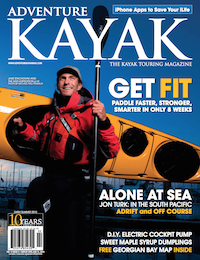 This article first appeared in the Early Summer 2010 issue of Adventure Kayak Magazine. For more great content, subscribe to Adventure Kayak’s print and digital editions here.
This article first appeared in the Early Summer 2010 issue of Adventure Kayak Magazine. For more great content, subscribe to Adventure Kayak’s print and digital editions here.



